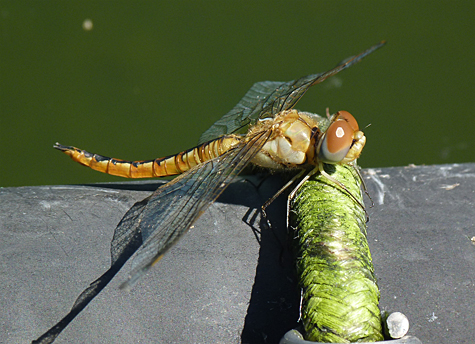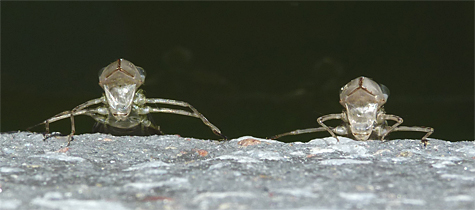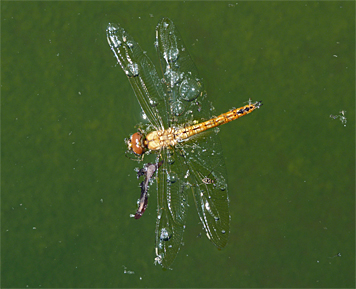I stopped by the Sail Boat Pond, as I often do on my routine hikes around the Outdoor Exhibits, and noticed a golden-hued dragonfly clinging to one of the bungee cords which holds in place the ABS tubing meant to keep the boats from ramming into the block wall of the pond. The dragonfly was a Wandering Glider (Pantala flavescens).

As I walked around the pond I noticed dragonfly exuviae hanging from the inner wall of the pond. Circumnavigating the pond I saw more and more of these exuviae. In all, I counted 58 cast off exoskeletons clinging to the walls and a handful more floating in the water. It had been a busy morning at the pond!

I see these odes at the Museum often, usually at the Sail Boat Pond, but they are widespread and can be seen just about anywhere. In fact, if you happen to see a dragonfly cruising your favorite shopping mall parking lot it’s likely to be one for these traveling odes, or its close relative the Spot-winged Glider (Pantala hymenaea). It’s not uncommon to see either of these gliders trying to oviposit on a shiny car hood, thinking the hood a pool of rain water!
The nymphal, aquatic stage of these dragonflies can be as short as 4 weeks. They are adapted to taking advantage of temporary pools of water in which to lay eggs since these dragons don’t stay put for long and are nearly always on the wing traveling from place to place.
They are cosmopolitan and migratory. I’ve heard reports of them being seen far from land out over the Indian Ocean, apparently migrating back and forth from Africa and the Indian Subcontinent. They have certainly been seen out over the Gulf Stream just off our coast.
A little closer to home, I’ve seen dragonflies oviposit in the Sail Boat Pond many times, including Wandering Gliders, but have never seen them emerge from the water as adults. Perhaps the nymphs didn’t survive due to the chemical treatment given the pond in order to control algae. The water would be quite turbid and the circulating pumps clogged were it not for the algae control in the pond.
I learned a few weeks ago that there is now a new algal control method in place, an ultrasonic control method. We use sound waves to kill the algae! Specific ultrasonic vibrations cause the cell walls of the algae to resonate and break with apparent fatal results for the algae.
The new exhibit in Catch the Wind, Into the Mist, which is next door to the Sail Boat Pond may also be contributing to the success of the dragonflies. During construction of Into the Mist there were two large cisterns built into the landscape (the hill on your right as you enter Into the Mist). These cisterns were designed to catch rain water and residual drainage from the mist.
The cisterns are doing there job very well. When the cisterns are full, which is often, the overflow is directed into the Sail Boat Pond adding to the pure clean water of the pond. This is preferable to using city water, which contains chlorine, to mantain the level of the pond. Although chlorine is lost to the atmosphere relatively quickly, the initial introduction of the disinfectant may do harm to the nymphs. Rainwater is much better for all involved.
Perhaps this is why, for the first time in five years, I’ve actually seen dragonfly exuviae at the Sail Boat Pond. The nymphs can now live long enough in the pond to mature.
Not all of the gliders that emerged that morning survived. I saw a half dozen or so floating in the water. I could see wing damage on a few of them. If the wings don’t dry out properly the dragonfly will not survive, a flightless dragonfly is a dead one. But, if the number of exuviae left clinging to the walls is any indication, there were many odes that were able to take wing and sail away.

All of the exuviae looked to be the same species, and in fact, all of the adults floating in the water were Wandering Gliders, except one, that is. I saw one Great Blue Skimmer floating in the pond. Had this dragonfly emerged that day as well, even though it was not able to take flight after emergence? Is this just a coincidence, or have Great Blue Skimmers also been able to successfully survive the nymphal aquatic stage in the Sail Boat Pond? We’ll have to wait and see if any more odes come to the surface.
